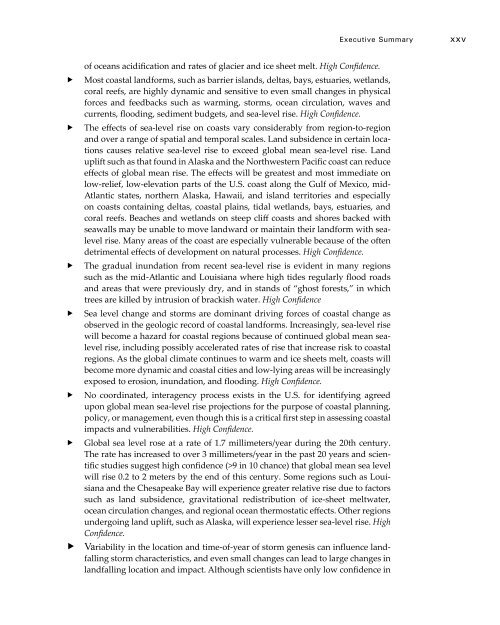Coastal Impacts, Adaptation, and Vulnerabilities - Climate ...
Coastal Impacts, Adaptation, and Vulnerabilities - Climate ...
Coastal Impacts, Adaptation, and Vulnerabilities - Climate ...
You also want an ePaper? Increase the reach of your titles
YUMPU automatically turns print PDFs into web optimized ePapers that Google loves.
Executive Summaryxxvffffffffffffffof oceans acidification <strong>and</strong> rates of glacier <strong>and</strong> ice sheet melt. High Confidence.Most coastal l<strong>and</strong>forms, such as barrier isl<strong>and</strong>s, deltas, bays, estuaries, wetl<strong>and</strong>s,coral reefs, are highly dynamic <strong>and</strong> sensitive to even small changes in physicalforces <strong>and</strong> feedbacks such as warming, storms, ocean circulation, waves <strong>and</strong>currents, flooding, sediment budgets, <strong>and</strong> sea-level rise. High Confidence.The effects of sea-level rise on coasts vary considerably from region-to-region<strong>and</strong> over a range of spatial <strong>and</strong> temporal scales. L<strong>and</strong> subsidence in certain locationscauses relative sea-level rise to exceed global mean sea-level rise. L<strong>and</strong>uplift such as that found in Alaska <strong>and</strong> the Northwestern Pacific coast can reduceeffects of global mean rise. The effects will be greatest <strong>and</strong> most immediate onlow-relief, low-elevation parts of the U.S. coast along the Gulf of Mexico, mid-Atlantic states, northern Alaska, Hawaii, <strong>and</strong> isl<strong>and</strong> territories <strong>and</strong> especiallyon coasts containing deltas, coastal plains, tidal wetl<strong>and</strong>s, bays, estuaries, <strong>and</strong>coral reefs. Beaches <strong>and</strong> wetl<strong>and</strong>s on steep cliff coasts <strong>and</strong> shores backed withseawalls may be unable to move l<strong>and</strong>ward or maintain their l<strong>and</strong>form with sealevelrise. Many areas of the coast are especially vulnerable because of the oftendetrimental effects of development on natural processes. High Confidence.The gradual inundation from recent sea-level rise is evident in many regionssuch as the mid-Atlantic <strong>and</strong> Louisiana where high tides regularly flood roads<strong>and</strong> areas that were previously dry, <strong>and</strong> in st<strong>and</strong>s of “ghost forests,” in whichtrees are killed by intrusion of brackish water. High ConfidenceSea level change <strong>and</strong> storms are dominant driving forces of coastal change asobserved in the geologic record of coastal l<strong>and</strong>forms. Increasingly, sea-level risewill become a hazard for coastal regions because of continued global mean sealevelrise, including possibly accelerated rates of rise that increase risk to coastalregions. As the global climate continues to warm <strong>and</strong> ice sheets melt, coasts willbecome more dynamic <strong>and</strong> coastal cities <strong>and</strong> low-lying areas will be increasinglyexposed to erosion, inundation, <strong>and</strong> flooding. High Confidence.No coordinated, interagency process exists in the U.S. for identifying agreedupon global mean sea-level rise projections for the purpose of coastal planning,policy, or management, even though this is a critical first step in assessing coastalimpacts <strong>and</strong> vulnerabilities. High Confidence.Global sea level rose at a rate of 1.7 millimeters/year during the 20th century.The rate has increased to over 3 millimeters/year in the past 20 years <strong>and</strong> scientificstudies suggest high confidence (>9 in 10 chance) that global mean sea levelwill rise 0.2 to 2 meters by the end of this century. Some regions such as Louisiana<strong>and</strong> the Chesapeake Bay will experience greater relative rise due to factorssuch as l<strong>and</strong> subsidence, gravitational redistribution of ice-sheet meltwater,ocean circulation changes, <strong>and</strong> regional ocean thermostatic effects. Other regionsundergoing l<strong>and</strong> uplift, such as Alaska, will experience lesser sea-level rise. HighConfidence.Variability in the location <strong>and</strong> time-of-year of storm genesis can influence l<strong>and</strong>fallingstorm characteristics, <strong>and</strong> even small changes can lead to large changes inl<strong>and</strong>falling location <strong>and</strong> impact. Although scientists have only low confidence in
















